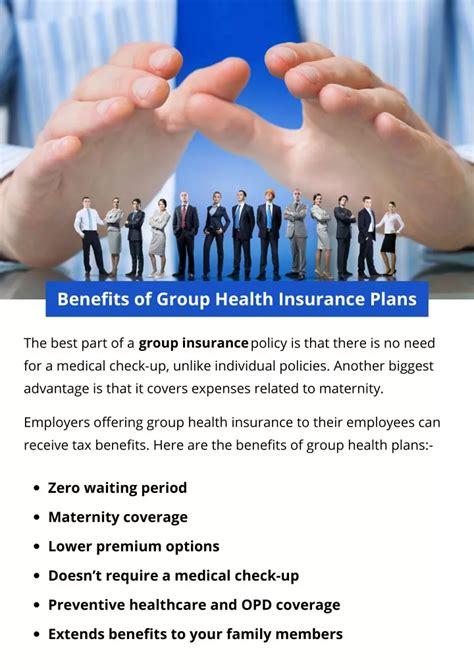Group Medical Insurance

Group medical insurance, also known as group health insurance or employer-sponsored health coverage, is a widely utilized benefit offered by organizations to their employees. This comprehensive insurance plan provides medical, surgical, and often additional benefits to a defined group of individuals, typically employees and their eligible dependents. In today's landscape, group medical insurance has become a crucial component of employee benefits packages, offering not only financial protection but also a range of advantages that enhance overall well-being and job satisfaction.
In this article, we will delve into the intricacies of group medical insurance, exploring its benefits, administration, and impact on both employees and employers. By understanding the nuances of this essential coverage, we can appreciate its role in fostering a healthy and productive workforce.
Understanding Group Medical Insurance

Group medical insurance operates on the principle of pooling resources to provide comprehensive health coverage to a defined group of individuals. The primary goal is to offer accessible and affordable healthcare options, ensuring that employees and their families have access to necessary medical services without facing significant financial burdens.
This type of insurance typically covers a wide range of medical expenses, including but not limited to:
- Hospitalization and surgical procedures
- Doctor visits and consultations
- Prescription medications
- Diagnostic tests and imaging
- Preventive care and wellness programs
- Mental health services
- Dental and vision care (often as separate riders)
Additionally, many group medical insurance plans offer additional benefits such as:
- Maternity and newborn care
- Chronic disease management
- Health and wellness coaching
- Discounts on fitness programs and healthy lifestyle initiatives
- Travel insurance and emergency assistance
The specific coverage and benefits vary depending on the plan chosen by the employer and the insurance provider. Employers often have the flexibility to customize the plan to meet the unique needs of their workforce, ensuring that the coverage aligns with the demographic and healthcare requirements of their employees.
Benefits of Group Medical Insurance for Employees

Financial Security and Peace of Mind
One of the most significant advantages of group medical insurance is the financial protection it provides. Employees can access necessary medical care without worrying about the high costs associated with healthcare services. This peace of mind extends to their families as well, ensuring that unexpected medical expenses do not become a financial burden.
Group medical insurance plans often cover a substantial portion of the cost of healthcare services, with employees paying a predetermined premium, which is typically more affordable than individual health insurance plans. This financial security allows employees to focus on their well-being and make informed decisions about their healthcare without financial constraints.
Comprehensive Coverage and Customization
Group medical insurance plans offer a wide range of coverage options, allowing employees to choose the level of protection that suits their individual needs. This customization ensures that employees can access the specific benefits they require, whether it’s specialized care for a chronic condition or comprehensive maternity coverage.
Additionally, many group plans provide access to a network of healthcare providers, giving employees the flexibility to choose from a diverse range of medical professionals and facilities. This network often includes discounted rates and preferred provider arrangements, further enhancing the value and accessibility of the coverage.
Preventive Care and Wellness Programs
Group medical insurance plans increasingly emphasize preventive care and wellness initiatives. These programs aim to promote healthy lifestyles, prevent illnesses, and manage chronic conditions effectively. By investing in preventive care, employers can help their employees stay healthy, reduce the risk of costly medical interventions, and improve overall productivity.
Wellness programs may include:
- Health risk assessments and personalized health plans
- Nutrition and fitness challenges
- Mental health support and stress management resources
- Tobacco cessation programs
- Chronic disease management workshops
By actively engaging in these programs, employees can take control of their health, leading to improved well-being and a sense of empowerment.
Access to Quality Healthcare
Group medical insurance plans often partner with reputable healthcare providers and facilities, ensuring that employees have access to high-quality medical care. This access to specialized services and experts can be particularly beneficial for employees with complex medical needs or rare conditions.
Additionally, many group plans offer second opinion services, allowing employees to seek expert advice and make informed decisions about their treatment options. This added layer of support can be invaluable in ensuring that employees receive the most appropriate and effective care.
Advantages for Employers
Attracting and Retaining Talent
In today’s competitive job market, offering comprehensive group medical insurance is a powerful tool for attracting top talent. Employees often prioritize benefits packages when considering job opportunities, and a robust healthcare plan can be a significant differentiator for employers.
By providing attractive healthcare coverage, employers can signal their commitment to employee well-being and work-life balance. This can lead to a more diverse and skilled talent pool, as employees with varying healthcare needs are more likely to consider and accept job offers that include comprehensive group medical insurance.
Enhancing Employee Productivity and Satisfaction
Group medical insurance has a direct impact on employee productivity and job satisfaction. When employees have access to quality healthcare and financial protection, they are more likely to be present and engaged at work. They can focus on their tasks without the added stress of worrying about their health or the well-being of their families.
Additionally, the preventive care and wellness programs offered through group medical insurance plans contribute to a healthier and more energized workforce. Employees who actively participate in these programs tend to experience improved physical and mental health, leading to increased productivity and a more positive work environment.
Cost Efficiency and Risk Pooling
Group medical insurance operates on the principle of risk pooling, where the premiums paid by all participants contribute to a larger pool of funds. This pooling mechanism helps to spread the financial risk associated with healthcare expenses across the entire group, making it more cost-effective for individual employees.
Employers also benefit from this risk pooling, as the cost of healthcare coverage is distributed among a larger group, reducing the financial burden on the organization. Additionally, many group plans offer incentives and discounts for employers who promote healthy lifestyles and implement effective wellness programs, further reducing overall healthcare costs.
Compliance with Regulatory Requirements
In many regions, offering group medical insurance is a legal requirement for employers with a certain number of employees. By providing this coverage, employers ensure that they meet their legal obligations and avoid potential penalties or legal consequences.
Furthermore, group medical insurance plans often include additional benefits and services that comply with specific regulatory requirements, such as mental health parity laws or coverage for pre-existing conditions. This ensures that employers are not only meeting their legal responsibilities but also providing a comprehensive and compliant benefits package to their workforce.
Administration and Implementation
Selecting the Right Plan
Choosing the right group medical insurance plan involves careful consideration of the needs and demographics of the employee population. Employers should conduct a comprehensive analysis of their workforce’s healthcare requirements, including common medical conditions, family needs, and preferred healthcare providers.
Based on this analysis, employers can work with insurance brokers or directly with insurance providers to design a plan that offers the right balance of coverage, flexibility, and cost-effectiveness. This process often involves evaluating different plan designs, such as:
- Preferred Provider Organizations (PPOs)
- Health Maintenance Organizations (HMOs)
- Exclusive Provider Organizations (EPOs)
- Point-of-Service (POS) plans
Each plan design has its own network of providers, coverage options, and cost structures, and the right choice will depend on the unique needs of the employer and their employees.
Employee Education and Communication
Once the group medical insurance plan is selected, effective communication and education are crucial to ensure that employees understand their benefits and how to utilize them. Employers should provide clear and concise information about the plan, including:
- Coverage details and exclusions
- Network providers and facilities
- Claim submission processes
- Wellness program offerings and incentives
- Dependent eligibility and coverage options
Employers can utilize various communication channels, such as employee handbooks, online portals, workshops, and one-on-one sessions, to ensure that employees have the necessary information to make informed decisions about their healthcare.
Enrollment and Ongoing Management
Group medical insurance plans typically require an annual enrollment period, during which employees can select their coverage options and make changes to their plans. This period provides an opportunity for employees to review their current coverage, consider any life changes (such as marriage or the birth of a child), and choose the most suitable plan for the upcoming year.
Employers are responsible for managing the enrollment process, ensuring that all eligible employees have the opportunity to enroll or make changes to their coverage. This may involve coordinating with insurance providers, setting up enrollment platforms or paper applications, and providing support to employees throughout the process.
Ongoing management of the group medical insurance plan involves regular monitoring of claim costs, utilization patterns, and employee satisfaction. Employers may need to make adjustments to the plan or explore alternative options if the current plan is not meeting the needs of the workforce or if costs become unsustainable.
Future Trends and Innovations

Digital Health and Telemedicine
The rise of digital health and telemedicine services has revolutionized the way healthcare is delivered and accessed. Group medical insurance plans are increasingly incorporating these technologies to enhance convenience and accessibility for employees.
Telemedicine services allow employees to consult with healthcare professionals remotely, often through video conferencing or secure messaging platforms. This can be particularly beneficial for employees with limited access to healthcare facilities or those who require convenient and discrete consultations.
Additionally, digital health platforms offer a range of services, including virtual fitness classes, mental health support groups, and personalized health tracking tools. These innovations not only improve access to care but also empower employees to take an active role in managing their health.
Personalized Medicine and Genomics
Advancements in personalized medicine and genomics are transforming the way healthcare is delivered. Group medical insurance plans are beginning to incorporate these innovations to offer more tailored and precise healthcare solutions.
Genomic testing and analysis can help identify an individual's unique genetic makeup, allowing for more precise diagnoses and targeted treatment plans. This approach can be particularly beneficial for employees with complex medical conditions or those at risk for certain diseases. By incorporating personalized medicine into group medical insurance plans, employers can provide employees with access to cutting-edge healthcare solutions.
Wellness Incentives and Gamification
Wellness programs within group medical insurance plans are evolving to include innovative incentives and gamification elements. These approaches aim to motivate employees to adopt healthy behaviors and actively participate in wellness initiatives.
Incentives may include rewards for meeting specific health goals, such as achieving a certain number of steps per day or completing a health assessment. Gamification elements, such as leaderboards and challenges, add a competitive and engaging aspect to wellness programs, encouraging employees to stay motivated and involved.
By incorporating these innovative approaches, employers can create a culture of wellness within their organizations, leading to improved overall health and reduced healthcare costs.
Conclusion
Group medical insurance is a powerful tool for fostering a healthy and productive workforce. By providing comprehensive healthcare coverage, employers can attract and retain top talent, enhance employee well-being, and promote a culture of wellness. The benefits extend beyond financial protection, offering employees access to quality healthcare, preventive care initiatives, and support for managing chronic conditions.
As we move forward, the evolution of group medical insurance will continue to be shaped by technological advancements, personalized medicine, and innovative wellness strategies. Employers who stay abreast of these trends and adapt their benefits packages accordingly will be well-positioned to meet the evolving needs of their workforce and contribute to a healthier and more productive future.
How does group medical insurance differ from individual health insurance plans?
+Group medical insurance is typically more affordable and offers a wider range of coverage options compared to individual health insurance plans. The risk pooling mechanism in group plans allows for more cost-effective premiums, and employers often provide additional benefits and support through wellness programs and access to a network of healthcare providers.
Can employees choose their own healthcare providers under group medical insurance plans?
+Yes, many group medical insurance plans offer flexibility in choosing healthcare providers. Employees can typically select from a network of providers, ensuring access to a diverse range of medical professionals and facilities. Some plans may also allow out-of-network coverage, although this may come with higher costs.
What are the key considerations for employers when selecting a group medical insurance plan?
+Employers should consider the healthcare needs and demographics of their workforce when selecting a group medical insurance plan. Factors such as common medical conditions, family needs, and preferred healthcare providers should be taken into account. Additionally, employers should evaluate plan designs, coverage options, and cost structures to find the right balance between affordability and comprehensive coverage.
How can employees maximize the benefits of their group medical insurance plan?
+Employees can maximize the benefits of their group medical insurance plan by actively engaging in wellness programs, taking advantage of preventive care services, and staying informed about their coverage and network providers. Regularly reviewing their plan’s details and understanding the claim submission process can also help employees make the most of their healthcare coverage.
What are some emerging trends in group medical insurance that employers should be aware of?
+Emerging trends in group medical insurance include the integration of digital health and telemedicine services, personalized medicine and genomics, and innovative wellness incentives. Employers should stay informed about these developments to ensure their benefits packages remain competitive and aligned with the evolving needs of their workforce.



